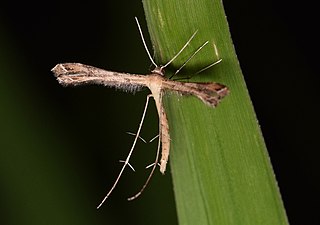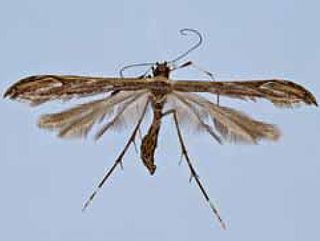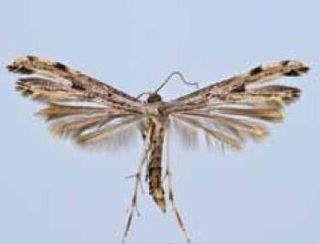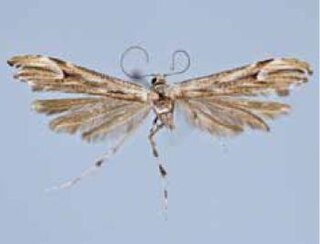
The Pterophoridae or plume moths are a family of Lepidoptera with unusually modified wings, giving them the shape of a narrow winged airplane. Though they belong to the Apoditrysia like the larger moths and the butterflies, unlike these they are tiny and were formerly included among the assemblage called "microlepidoptera".

Pterophorus pentadactyla, commonly known as the white plume moth, is a moth in the family Pterophoridae. It is found in the West Palearctic including North Africa and Europe. The wingspan is 26–34 mm (1.0–1.3 in). It is uniformly white, with the hind wing pair divided in three feathery plumes and the front pair in another two. The moths fly from June to August. The larvae feed on bindweed.

Stenoptilia pterodactyla, the brown plume is a moth of the family Pterophoroidea. It is found in Europe, North America, Anatolia, Iran and China. It was first described by the Swedish taxonomist, Carl Linnaeus in 1761.

Amblyptilia acanthadactyla, also known as the beautiful plume, is a moth of the family Pterophoroidea found in across the Palearctic including Europe. The species was first described by the German entomologist, Jacob Hübner in 1813.

Sphenarches anisodactylus, commonly known as the geranium plume moth, is a species of moth in the family Pterophoridae. It is found in western Africa, Madagascar, India, Sri Lanka, Thailand, Japan, the New Hebrides and Central and South America, as well as Australia, where it has been recorded from Cape York to central New South Wales. It is found in the United States, where it has been recorded from Florida, as well as Mississippi. It is also present in the Kermadec Islands of New Zealand.

Stenoptilodes taprobanes is a moth of the family Pterophoridae. This species has a pantropical distribution, which extends into subtropical areas.

Pterophorus albidus is a moth of the family Pterophoridae. It is distributed in Africa, south and south-east Asia, including New Guinea and Australia, as well as Japan (Kyushu) and the Ryukyu Islands.
Nippoptilia cinctipedalis is a moth of the family Pterophoridae. It is found in Australia, Korea, Japan (Kyushu), China, Micronesia, the Republic of Palau and Vietnam.

Hellinsia beneficus is a moth of the family Pterophoridae. It is native to Mexico, but was introduced to Hawaii in 1973 as a biological control agent against mistflower, Ageratina riparia.

Platyptilia farfarellus is a moth of the family Pterophoridae. The species was described by Philipp Christoph Zeller in 1867. It is found from central and southern Europe to Asia Minor, Micronesia and Japan. It is also known from Africa, where it has been recorded from Equatorial Guinea, Kenya, Madagascar, Mauritius, Nigeria, South Africa, São Tomé & Principe, Tanzania, Uganda, the Seychelles and Malawi.

Amblyptilia punctidactyla, also known as the brindled plume, is a moth of the family Pterophoridae found across the Palearctic. The species was first described by the English entomologist, Adrian Hardy Haworth in 1811.
Nippoptilia issikii is a moth of the family Pterophoridae, that is known from Japan (Hokkaido), and Korea and China.

Hellinsia distinctus is a moth of the family Pterophoridae that is found from Europe to India, Korea, Japan, China and Russia. Within Europe, it is found from Germany and the Benelux east to Poland, Slovakia, Hungary and Romania, from Italy north to Fennoscandia, and in Greece, Estonia, Latvia and northern and central Russia.
Paraplatyptilia auriga is a moth of the family Pterophoridae described by William Barnes and Arthur Ward Lindsey in 1921. It is found in eastern North America, including Florida, Mississippi, and New Jersey.

Adaina ambrosiae is a moth of the family Pterophoridae. It is found in North America from California east to Florida and north to Ontario. It is also known from Bermuda, Costa Rica, Jamaica, Puerto Rico and the Virgin Islands.

Hellinsia inquinatus is a moth of the family Pterophoridae. It is found in North America, including Florida, Mississippi, Oklahoma, Tennessee, Maryland, Alabama, Texas, Missouri, Colorado and Arizona. It has also been recorded from Hispaniola, Mexico, Puerto Rico and St. Thomas Island.

Oidaematophorus eupatorii, the eupatorium plume moth or Joe Pye plume moth, is a moth of the family Pterophoridae. It is found in North America, including Florida, Mississippi, Iowa, New York, California and Vancouver Island. It is also known from Mexico, Guatemala and Panama.

Amblyptilia pica, the geranium plume moth, is a moth of the family Pterophoridae. The species was first described by Baron Walsingham in 1880. It is found in western North America from Alaska to California, inland to Alberta and Kansas. It is also found in the north-eastern United States and Ontario.

Oidaematophorus phaceliae is a moth of the family Pterophoridae that is found from Yukon to Ontario, south to California and Baja California. The habitat consists of boreal forest.

Hellinsia ochracealis is a moth of the family Pterophoridae. It is found in Brazil, Nicaragua, Colombia and Peru.
















